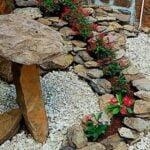Cinder block gardening ideas have gained popularity in recent years as a cost-effective and versatile way to create stunning garden structures. Utilizing cinder blocks, also known as concrete blocks, can provide a solid foundation for planting and landscaping, making them an ideal choice for both beginner and experienced gardeners.
But what exactly is cinder block gardening? This innovative approach involves using cinder blocks to create raised beds, planters, retaining walls, and even vertical gardens. The benefits of cinder block gardening are numerous, including improved drainage, reduced erosion, and the ability to customize the layout to fit any outdoor space.
In this article, we will explore the endless possibilities of cinder block gardening, from choosing the right blocks for your garden to creative ways to arrange them for various garden structures. We will also provide planting tips, DIY project ideas for beginners, and inspiration for vertical gardening in small spaces. Whether you’re looking to enhance your backyard or create a beautiful urban oasis on a balcony or rooftop, cinder block gardening offers a practical and visually appealing solution.
Choosing the Right Cinder Blocks for Your Garden
When it comes to choosing the right cinder blocks for your garden, there are a few key factors to consider. The type of cinder blocks you choose will depend on the size and layout of your garden, as well as the specific structures or features you plan to build. Here are some tips for selecting the best cinder blocks for your gardening project:
- Size: Consider the size of the cinder blocks in relation to the scale of your garden. Larger blocks can be used to create bigger structures like raised beds or retaining walls, while smaller blocks are better suited for smaller projects like planters or borders.
- Shape: Cinder blocks come in a variety of shapes, including standard rectangular blocks, corner blocks, and cap blocks. Choose the shape that best fits the design and layout of your garden structures.
- Material: While traditional cinder blocks are made from concrete, there are also lightweight alternatives available that are easier to work with, especially for DIY projects. Consider the weight and material of the cinder blocks based on your own physical capabilities and project requirements.
Once you have selected the right cinder blocks for your garden, it’s time to get creative with how you arrange them. Whether you’re building raised beds, seating areas, or decorative features, there are endless possibilities for arranging cinder blocks in your garden to create functional and attractive structures. With a little imagination and planning, you can transform a stack of cinder blocks into a unique and personalized garden space that suits your needs and style.
Creative Ways to Arrange Cinder Blocks for Various Garden Structures
Cinder blocks are a versatile and affordable material for creating various garden structures. Whether you’re looking to build raised beds, seating areas, or even decorative garden walls, there are plenty of creative ways to arrange cinder blocks in your garden.
One popular approach is to stack the cinder blocks in different configurations to create different levels for raised beds. This not only adds visual interest to your garden but also allows for better organization of different plants based on their soil and sunlight needs. You can also use the hollow spaces of the cinder blocks to create mini planters for herbs or flowers, adding an extra layer of functionality to your garden structure.
Another creative way to arrange cinder blocks is by using them as a foundation for a vertical garden. By stacking the blocks horizontally with openings facing outwards, you can create pockets for planting trailing vines, succulents, or other low-maintenance plants. This not only maximizes space in small gardens but also adds an eye-catching focal point to your outdoor space.
For those wanting to add seating areas or retaining walls in their garden, stacking the cinder blocks horizontally can create sturdy and aesthetically pleasing structures. You can even mix and match different colors or paint the blocks for a personalized touch that complements your overall garden design.
But regardless of how you choose to arrange your cinder blocks in the garden, it’s important to ensure they are stacked securely and leveled properly to avoid any safety hazards or structural issues over time.
| Creative Ways | Benefits |
|---|---|
| Versatile use in creating various garden structures | Allows better organization and functionality in the garden |
| Maximizes space in small gardens | Strengthens safe and aesthetically pleasing structures |
Planting Tips for Cinder Block Gardens
Cinder block gardening offers a versatile and practical way to create a beautiful and functional garden space. Whether you are new to gardening or have years of experience, there are several tips and tricks to keep in mind when planting in cinder block gardens. Here are some essential tips to help you make the most of your cinder block garden:
- Proper Soil Preparation: Before planting in your cinder block garden, it’s crucial to prep the soil properly. Consider using a high-quality potting mix that is well-draining and nutrient-rich. You can also add compost or organic matter to improve the soil’s fertility.
- Plant Selection: When choosing plants for your cinder block garden, consider the mature size of each plant and its growth habits. Since cinder blocks come in standard sizes, plan your plantings accordingly and ensure that larger plants have enough space to grow.
- Watering Techniques: Proper watering is essential for the success of any garden, including cinder block gardens. Consider installing a drip irrigation system or watering at the base of the plants to prevent water waste and promote healthy root development.
- Companion Planting: Take advantage of companion planting techniques to maximize space and promote natural pest control in your cinder block garden. For example, pairing certain vegetables with aromatic herbs or flowers can help deter pests and attract beneficial insects.
By following these planting tips for your cinder block garden, you can create a thriving and abundant oasis right in your backyard. With some creativity and careful planning, your cinder block garden will be a source of joy and beauty for years to come.
DIY Cinder Block Garden Projects for Beginners
When it comes to DIY cinder block gardening projects, there are countless possibilities for beginners to explore. From simple raised beds to more complex outdoor furniture, cinder blocks can be a versatile and affordable material for any garden project.
Planter Boxes and Raised Beds
One of the easiest DIY cinder block gardening projects for beginners is creating planter boxes or raised beds. By stacking cinder blocks in a rectangular shape and filling them with soil, you can create a sturdy and long-lasting container for flowers, herbs, or vegetables. This is a great project for those new to gardening, as it requires minimal tools and can be easily customized to fit any outdoor space.
Cinder Block Bench or Table
For those looking to add some functional furniture to their garden, constructing a cinder block bench or table is another beginner-friendly project. By arranging the blocks in a creative pattern and adding a sturdy wooden plank on top, you can quickly and easily create an outdoor seating area or work surface. This project not only adds visual interest to your garden but also provides a convenient place to relax or work outdoors.
Cinder Block Compost Bin
Composting is an essential part of any garden, and creating a DIY compost bin from cinder blocks is a simple yet effective project for beginners. By stacking the blocks in a square or rectangular shape with openings for air circulation, you can easily create an efficient composting system that will help nourish your garden’s soil. Plus, the sturdy construction of the cinder blocks ensures that your compost bin will stand up to years of use.
These DIY projects are just the beginning when it comes to using cinder blocks in your garden. With a little creativity and some basic tools, beginners can quickly bring their gardening ideas to life with this versatile material. Whether you’re looking to add structure, functionality, or visual appeal to your outdoor space, cinder blocks offer endless possibilities for both experienced and novice gardeners alike.
Vertical Cinder Block Gardening Ideas for Small Spaces
For those living in apartments or homes with limited outdoor space, vertical gardening is a great solution. Vertical gardens are not only space-saving but also visually appealing, and cinder blocks can be the perfect material to create these types of gardens. By utilizing the vertical space, you can grow a variety of plants, flowers, herbs, and even vegetables without taking up too much room.
One creative idea for vertical cinder block gardening is to stack the blocks in a pyramid shape, creating multiple tiers for planting. This structure allows for different types of plants to be grown on each level, making it both functional and aesthetically pleasing. Another idea is to create a cascading effect by stacking the blocks in a staggered pattern, allowing plants to overflow from each opening.
When it comes to small spaces, it’s essential to make the most out of every available area. Hanging planters made from cinder blocks can be an excellent way to add greenery to your walls or fences. By attaching hooks or brackets to the blocks and hanging them at various heights, you can create a dynamic and eye-catching vertical garden.
In addition to traditional planting, vertical cinder block gardens can also be used as a backdrop for artistic elements. Incorporating decorative elements such as sculptures, colorful containers, or upcycled materials into your vertical garden will not only add visual interest but also maximize the impact of your limited space.
Maintenance and Care for Cinder Block Gardens
When it comes to maintaining and caring for your cinder block garden, there are a few key things to keep in mind to ensure your plants thrive. One important aspect of maintenance is regularly checking the cinder blocks themselves for any signs of wear or deterioration. Over time, these blocks may become damaged due to exposure to the elements, so it’s important to replace any broken or crumbling blocks as needed.
In terms of caring for your plants, proper watering and fertilizing are essential. Cinder block gardens can be prone to drying out quickly, so it’s important to monitor the moisture levels of the soil and water accordingly. Additionally, incorporating a regular feeding schedule with the appropriate fertilizer will help promote healthy growth and blooming for your garden.
Another aspect of maintenance for cinder block gardens is keeping an eye out for any weeds that may pop up between the blocks. Regular weeding will help prevent unwanted competition for nutrients and resources that your plants need to thrive. By staying on top of these maintenance tasks, you can ensure that your cinder block garden continues to flourish throughout the growing season.
In addition to regular maintenance tasks, it’s also important to keep an eye out for any pests or diseases that may affect your plants. Inspecting your garden on a regular basis will allow you to catch any issues early on and take the necessary steps to address them effectively. With proper care and attention, your cinder block garden can be a beautiful and thriving oasis in your outdoor space.
Inspiring Examples of Beautiful Cinder Block Gardens
Cinder block gardening has become a popular trend for many gardeners, and for a good reason. The use of cinder blocks in gardening not only adds an industrial and modern aesthetic to your outdoor space but also offers a variety of benefits. From their affordability and durability to their versatility in creating different garden structures, cinder blocks have proven to be an excellent choice for both novice and experienced gardeners.
Colorful Raised Beds
One creative way to use cinder blocks in your garden is by creating colorful raised beds. By painting the cinder blocks in vibrant colors, you can add a pop of personality to your garden while also effectively containing your plants and flowers. This is a great way to add visual interest and create defined spaces within your garden.
Chic Garden Benches
Another inspiring example of beautiful cinder block gardens is the use of these blocks to construct chic garden benches. Stack the cinder blocks horizontally and vertically to form a sturdy base, then place wooden boards or cushions on top for seating. Not only does this provide functional seating in your garden, but it also adds a unique touch to your outdoor space.
Decorative Garden Borders
Using cinder blocks as decorative garden borders is another effective way to showcase the versatility of these building materials. By stacking the blocks in various arrangements, you can create interesting patterns and shapes that define different sections of your garden. Additionally, filling the cavities of the blocks with soil allows for planting small flowers or succulents, adding an extra element of greenery to your borders.
These examples demonstrate how cinder block gardening ideas can bring both functionality and beauty to your outdoor space. With some creativity and DIY spirit, you can transform simple cinder blocks into stunning features that enhance the overall appeal of your garden.
Conclusion
In conclusion, cinder block gardening offers a wide range of benefits and possibilities for creating beautiful and functional outdoor spaces. From its versatility in structure and design to its affordability and durability, cinder block gardening is a practical and creative way to elevate your garden. Whether you are a novice gardener looking for a simple DIY project or an experienced green thumb seeking innovative solutions for limited space, cinder blocks provide endless opportunities for creative expression.
As you explore the world of cinder block gardening ideas, remember to carefully consider the type of cinder blocks you use and how they will complement your garden. The right selection of materials can make all the difference in creating a cohesive and attractive outdoor space. Additionally, take advantage of vertical gardening techniques to maximize your available space and create a stunning visual impact.
With proper maintenance and care, your cinder block garden has the potential to thrive throughout the seasons, providing you with a fulfilling hobby that yields fruits, vegetables, flowers, or herbs. By implementing the planting tips shared in this article and experimenting with various arrangements and structures, you can personalize your garden into a unique oasis that reflects your style while enjoying the satisfaction of growing your own produce.
In essence, the possibilities for cinder block gardening are truly endless; so let your imagination run wild as you embark on this exciting journey.
Frequently Asked Questions
What Grows Well in Cinder Blocks?
Many types of plants grow well in cinder blocks, especially those with shallow root systems like herbs, succulents, and small vegetables. They provide good drainage and can be easily arranged to create a variety of planting configurations.
Is It Safe to Use Cinder Blocks for Gardening?
It is generally safe to use cinder blocks for gardening, but there are some precautions to take. The blocks can leach lime and other chemicals into the soil, so lining them with plastic or landscape fabric is recommended. Additionally, using a food-safe sealant can further prevent any potential contamination.
How Do You Use Cinder Blocks in a Garden?
Cinder blocks can be used in a garden in many ways. They are commonly used to create raised beds, planters, or retaining walls.
They can also be stacked and filled with soil to create vertical gardens or used as a base for a greenhouse or compost bin. The versatility of cinder blocks makes them a popular choice for gardeners looking for affordable and customizable options.

Welcome to my gardening blog! I am passionate about plants and enjoy sharing my knowledge and experiences with others. In this blog, I will write about everything related to gardening, from tips on how to get started to updates on my own garden projects.





